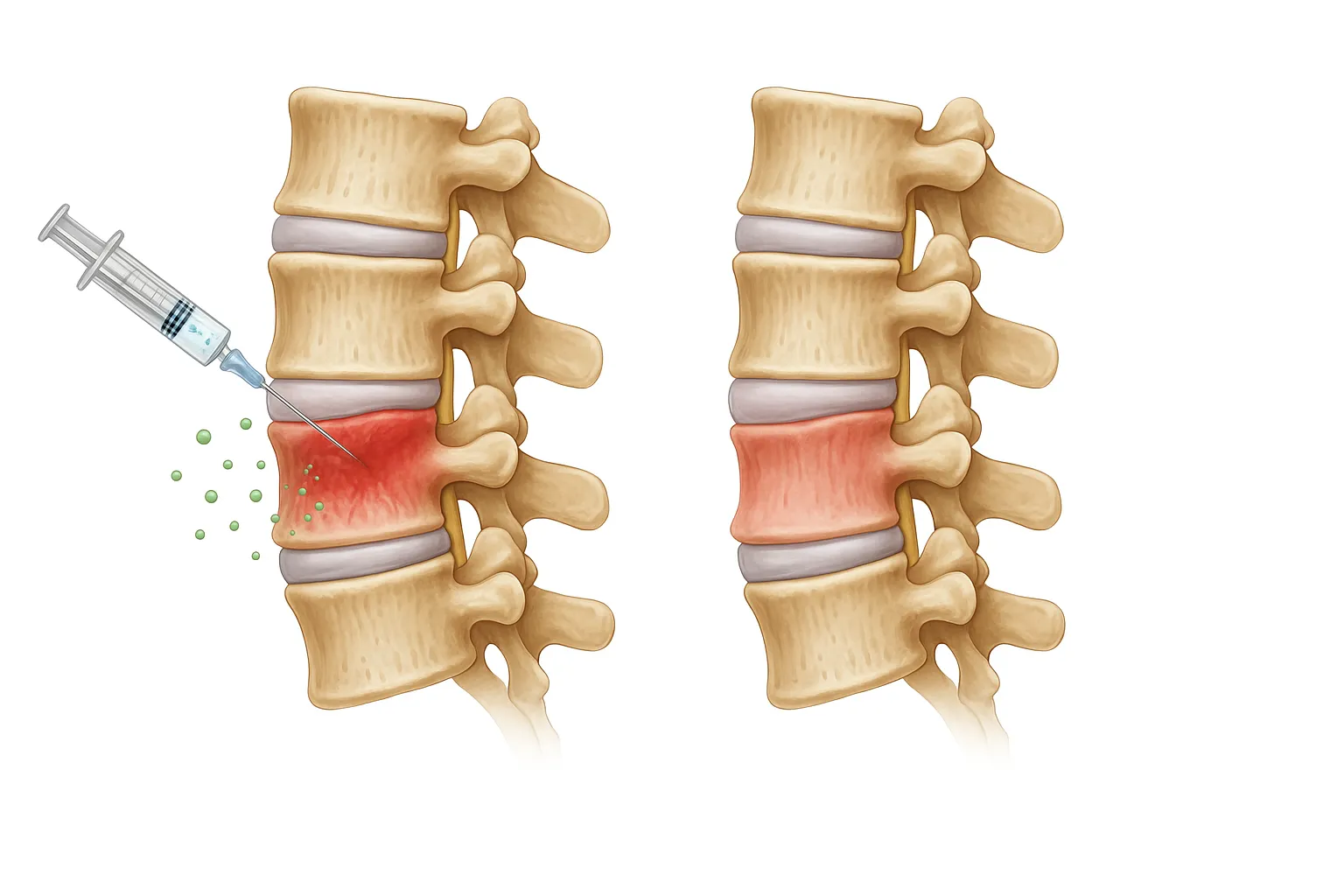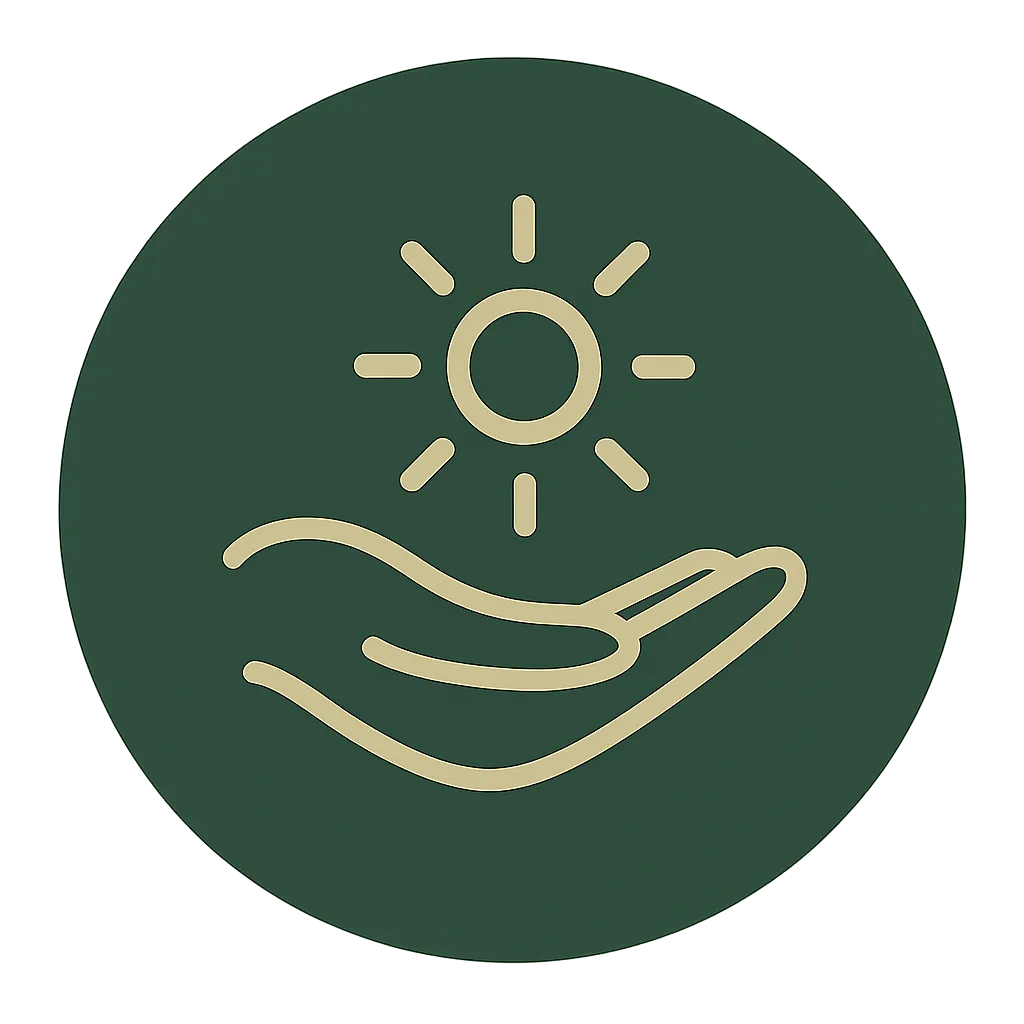Back pain is one of the most common and debilitating conditions, affecting millions of people worldwide. While traditional treatments like physiotherapy, painkillers, and surgery can offer some relief, they often don’t address the root cause. Enter Stem Cell Therapy, a treatment with the potential to repair damaged tissues and provide lasting relief for chronic back pain. But how does it work, and is it worth considering?
How Do Stem Cell Treatments Help with Back Pain? The Science Explained
Stem cell therapy for back pain works by calming inflammation, repairing damaged discs and joints, and encouraging the body to heal itself naturally.
In theory, these cells can turn into new disc or cartilage tissue. But so far, most MRI scans haven’t shown that happening. But it could also be not many studies have looked for it closely, so we just don’t know yet. To break it down further:
Reducing Inflammation
Stem cells release special proteins that calm inflammation in spinal discs and joints, easing pain and swelling.
Repairing Damaged Tissues
They help regenerate the cartilage, bone, or nerve cells that have been damaged by injury, aging, or wear and tear.
Boosting Recovery
By encouraging new blood vessel growth, stem cells enhance nutrient delivery to injured areas, speeding up the healing process.

How Stem Cells Can Help Reduce Inflammation in Back Pain

Anti-Inflammatory Signals
Source: AltTreatment.io
To learn more about the full process, check out this article explaining how Stem Cell Therapy works in detail.
What Types of Back Pain Can Stem Cell Therapy Treat?
Stem cell therapy may help treat chronic lower back pain, herniated discs, degenerative disc disease, spinal arthritis, sciatica, and even some spinal cord injuries by reducing inflammation and repairing damaged tissues. Here’s a quick look at the types of back pain it may help:
1. Degenerative Disc Disease Stem Cell Treatments
Think of your spinal discs like shock absorbers. Over time, they can wear out, causing pain and stiffness. Stem cells step in to regenerate these damaged discs, potentially improving both comfort and mobility.
2. Herniated Discs Stem Cell Treatments
A herniated disc can press on your nerves, leading to sharp pain and even numbness. Stem cell therapy aims to reduce inflammation and repair the damaged disc tissue, offering relief without the need for invasive surgery.
3. Spinal Arthritis (Facet Joint Pain) Stem Cell Treatments
If arthritis in your spine makes every movement feel stiff and painful, stem cells can help calm the inflammation and improve joint health, giving you more freedom to move.
4. Sciatica Stem Cell Treatments
That shooting pain down your leg? Stem cells could help. By targeting the inflamed or compressed sciatic nerve, they may ease discomfort and encourage natural healing.
5. Can Stem Cells treat Chronic Lower Back Pain?
Yes, stem cell therapy may help with chronic lower back pain by targeting damaged spinal discs, inflammation, and slow-healing injuries. Unlike steroid injections, which only provide temporary relief, stem cells aim to repair tissue and reduce inflammation at the source.
6. Spinal Cord Stem Cell Treatments
While still experimental, early research shows promise for using stem cells to repair nerve damage and potentially restore function in cases of spinal cord injury.
Stem Cell Treatment Process for Back Pain
1. Evaluation
Doctors review your history, symptoms, and scans to decide if stem cell therapy is a good fit.
2. Collecting the Cells
Cells may come from your own bone marrow or fat, or from donated umbilical cords (no surgery needed).
3. Prepping the Cells
Once collected, cells are spun and processed in a lab to concentrate their healing signals before injection.
4. Injection
Stem cells are injected into or around the spine using ultrasound or X-ray guidance. Most patients go home the same day.
5. Recovery
Recovery usually takes 2–6 weeks. You can walk normally but should avoid intense activity early on.
Stem Cell Therapy for Back Pain Recovery Time
Recovery time for Stem Cell Treatment on your back takes 2-6 weeks to let the stem cells work. You’ll be able to walk around pretty much straight away, but you should avoid high impact activities.
Types of Stem Cells being explored for Back Pain
Doctors and scientists are trying different types of stem cells to see which ones work best for healing discs, easing pain and fixing spine damage.
Bone Marrow Mesenchymal Stem Cells (BM-MSCs)
These are commonly used & studied for back pain caused by degenerative disc disease (DDD). BM-MSCs can potentially help repair damaged discs by promoting tissue regeneration and reducing inflammation.
Umbilical Mesenchymal Stem Cells (U-MSCs)
These cells are used in therapies for back pain, particularly because of their anti-inflammatory properties and potential to repair damaged tissues.
Adipose-Derived Mesenchymal Stem Cells (AD-MSCs)
Since these are easily harvested from fat tissue, they are a popular choice for treating back pain caused by conditions like disc degeneration. Their abundance and ability to release anti-inflammatory factors make them a viable option.
Neural Stem Cells (NSCs) and Neural Progenitor Cells (NPCs)
NSCs are not typically used directly for back pain but are relevant in cases involving nerve damage, such as sciatica or spinal cord injuries that contribute to chronic pain.
Induced Pluripotent Stem Cells (iPSCs)
These are more experimental and not yet commonly used in back pain treatment due to their complexity and cost. However, they offer the potential to regenerate damaged tissues in the spine.
Extracellular Vesicles (EVs) from Stem Cells
EVs, derived from stem cells, are being explored as a less invasive alternative for treating back pain by delivering regenerative and anti-inflammatory signals to affected areas.
How Much Does Stem Cell Therapy for Back Pain Cost in the US and UK?
Stem cell therapy for back pain costs between $8,000–$50,000 in the US and £8,000–£30,000 ($10,000–$37,000 USD) in the UK, depending on the clinic, treatment type, and number of stem cells used. Here’s a deeper breakdown:
United Kingdom: In the UK, private clinics offer stem cell therapy for back pain at rates between £8,000 and £30,000 ($10,000–$37,000 USD). Also, remember this treatment isn’t available on the NHS, so you would have to go to a private clinic if you’re in the UK!
United States: Costs typically range from $8,000 to $50,000, depending on the clinic, the type of stem cells used, and the complexity of the treatment. Advanced procedures like intradiscal stem cell injections tend to be on the higher end of the spectrum.
To look at average costs of Stem Cell Therapy in different regions, our article on Stem Cell Therapy costs in different countries might be useful!
Living with back pain is exhausting especially when nothing seems to work. We’re not here to tell you what to do or push you towards random treatments. Our aim is to enable you to decide for yourself whether it's worth exploring and connect you to clinics we’ve personally vetted.
Get Free GuidanceNo pressure. No spam. Just honest advice to help choose the right clinic.
What other countries use Stem Cells to treat Back Pain?
Countries like Colombia, Panama, Japan, South Korea, Thailand and Dubai use stem cells to treat back pain.
Each country has different regulations and treatment options. Check out our guide to the best countries for stem cell therapy to compare.
How much does Stem Cell Therapy for Back pain cost around the world?
Stem Cell Therapy for Back pain costs range from $8,000 to $15,000 globally. Here's a rough breakdown of how much back pain stem cell treatments cost around the world. We've gathered our data in a few different ways & we're always updating it!
- Colombia: $15,000. View Colombia Cost Guide for more details.
- Thailand: $8,000 - $10,000. View Thailand Cost Guide for more details.
What are the risks of getting Stem Cell Treatments for Back Pain?
Stem cell therapy for back pain shows promise, but it’s still experimental. Risks include limited long-term data, possible nerve irritation from injections, and the need for additional treatments for complex injuries.
Despite some promising results, it might be too soon to say whether Stem Cell Therapy for back injuries will become a standard treatment. Here’s why:
- Limited Long-Term Data: Most trials are still in their early stages. We lack robust, long term data on the effectiveness and safety of these treatments. Researchers are unsure how well the benefits will last or if there are any long-term risks.
- Nerve damage: If the injection isn’t placed correctly, it could irritate nerves and worsen pain. Most top clinics use fluoroscopy (real-time X-ray guidance) to minimize this risk and ensure precise placement.
- Need for Combined Therapies: Stem cell therapy on its own may not be enough to treat complex injuries like SCI. Researchers increasingly believe that combined treatments using stem cells alongside other therapies, like growth factors or neuroprotective drugs may be more effective in achieving meaningful recovery.
To learn more about the side effects, check out our article on the long term side effects of Stem Cell Therapy.
Stem Cell Therapy vs. Traditional Back Pain Treatments

| Treatment | Cost | Effectiveness | Longevity | Risks |
|---|---|---|---|---|
| Stem Cell Therapy | $5,000–$50,000 | Promising for reducing inflammation and repairing tissue | Potentially 1–5 years, more research needed | Experimental. Results are varied from patient to patient |
| Cortisone Injections | $1,000–2,500 per shot | Effective for short-term pain relief | A few months | Can weaken cartilage if overused |
| Physical Therapy | $50–$200 per session | Gradual improvement in mobility and strength | Varies by condition | Minimal risk; requires consistent effort |
| PRP (Platelet-Rich Plasma) | $2,000–$5,000 | May improve healing and reduce pain | 6–12 months | Mild swelling or discomfort post-procedure |
Looking into Stem Cell Clinics for Back Pain?
Compare verified stem cell clinics offering back pain treatments in places like Colombia, Japan and the UAE. We only list clinics we’ve personally reviewed for safety, credibility, and patient experience.
Browse Verified Stem Cell ClinicsWhat does the research say about Stem Cell Therapy for Back Pain
The research into stem cell therapy & Stem cell products for back pain is still evolving, but here are some highlights:
BRTX-100 Stem Cell Therapy for Chronic Lower Back Pain
(To read more about the study yourself, here’s the press release they released on May 13th 2025!)
Who’s Running This Study?
BioRestorative Therapies, Inc. is conducting this Phase 2 clinical trial to test BRTX-100. A stem cell treatment aimed at people with chronic lumbar disc disease (cLDD), a common cause of long-term lower back pain. What makes it unique? BRTX-100 uses a patient’s own bone marrow stem cells, but they’re specially grown in low-oxygen (hypoxic) conditions, which may help them survive better and repair damaged tissue more effectively.
Who Took Part?
The early data includes 15 participants (but the full trial will include up to 99). To join, patients had to have:
- Lower back pain due to lumbar disc degeneration.
- Persistent symptoms despite trying other treatments like physical therapy or pain medications.
How Did It Work?
Each patient received a single injection of 40 million (40×10⁶) mesenchymal stem cells from their own bone marrow, given directly into the damaged disc. Before the injection, the stem cells were blended with something called platelet lysate. A mix of healing proteins taken from the patient’s own blood. This gives the cells an extra boost, helping them survive longer, send better signals to reduce inflammation, and kickstart the body’s natural repair process once they’re inside the damaged disc. Together, this combo may lead to better long-term relief and help some patients avoid surgery altogether. This is a randomized, double-blind study, meaning neither patients nor doctors know who got the real treatment vs. the placebo.
Did the Stem Cells actually rebuild the disc?
BioRestorative didn’t track whether the stem cells turned into new disc tissue. There were no cell labels, no biopsies, and no imaging results showing new disc formation. That means there’s no direct proof the cells differentiated (transformed) into disc cells. But what we do have is growing evidence that the treatment helped reduce pain and improve function over time without serious side effects. Given that, and the fact the stem cells were specially prepared to survive longer and release healing proteins, it’s far more likely that they worked by sending out regenerative signals (not by becoming new tissue themselves). In simple terms: the cells acted more like coaches giving instructions, not turning into new cells themselves.
Results So Far
Safe So Far: No serious side effects have been reported up to 2 years post-injection.
Pain & Disability Improvements: A growing number of patients showed major improvements over time. Here's the percentage of patients who saw over 50% pain and disability reduction at different checkpoints:
- Week 2: 0%
- Week 12: 13%
- Week 26: 46%
- Week 52: 70%
- Week 104: 67%
What This Means
These early results are super encouraging. BRTX-100 may offer a non-surgical, long-term solution for people struggling with chronic back pain due to disc problems. The fact that pain and disability improvements increased over time suggests real regenerative benefits. Because the treatment uses your own cells, there's no risk of immune rejection.
Next Steps
The trial is still ongoing and expanding to include more participants. If future data stays positive, BRTX-100 could become a new gold standard for treating lower back disc issues, especially for people trying to avoid surgery.
CELZ-201-DDT Stem Cell Therapy for Chronic Lower Back Pain
(To read more about the study yourself, here’s the press release & here’s the study page)
Who’s Running This Study?
Creative Medical Technology Holdings, Inc. (CELZ) is conducting this Phase 1/2a clinical trial to evaluate the safety, tolerability, and effectiveness of CELZ-201-DDT, an allogeneic (donor-derived) stem cell therapy for patients suffering from degenerative disc disease and chronic lower back pain. The just announced results in January 2025! The trial uses umbilical cord-derived mesenchymal stem cells (UC-MSCs). But here’s the catch, Creative Medical has modified these cells using their own process to enhance their anti-inflammatory and regenerative properties for treating chronic lower back pain.
Who Took Part?
10 participants with chronic lower back pain caused by degenerative disc disease. Patients were required to have persistent pain for at least 6 months and have tried other treatments (e.g., painkillers, physiotherapy, or injections) without success.
How Did It Work?
Participants were randomly divided into three dose groups plus a placebo group. Each patient received six intramuscular injections (three injections per side of the lumbar paraspinal muscles) under ultrasound guidance.
- Low-dose group: Received 6 million (6×10⁶) stem cells.
- Medium-dose group: Received 30 million (30×10⁶) stem cells.
- High-dose group: Received 60 million (60×10⁶) stem cells.
- Placebo group: Received an injection without stem cells.
Results So Far
✅ No major safety concerns – The therapy was well tolerated, with no serious adverse effects reported in the first cohort.
✅ Pain Reduction – Early data suggests that patients receiving CELZ-201-DDT experienced decreased pain levels.
✅ Improved Mobility – The treatment showed potential for enhancing physical function and reducing disability scores in patients.
What This Means
Early results are promising, but more data is needed to confirm long-term effectiveness. CELZ-201-DDT could provide a non-surgical, regenerative alternative for chronic back pain sufferers. Higher doses may be more effective, but further trials are needed to determine the optimal dosage. So far, there’s no evidence that the stem cells actually turned into new tissue. Instead, it looks like they worked by sending out healing signals. Reducing inflammation, calming irritated nerves, and helping the body feel better naturally.
Next Steps
The trial is ongoing and continuing enrollment toward its target of 30 participants. Each patient will be followed for 12 months to evaluate long-term safety, pain relief, and functional improvements.
Umbilical Cord Stem Cell Product Trial for Chronic Lower Back Pain
(To read more about the study yourself, here’s the source!)
Who’s Running This Study?
A South Korean biotech company, CHABiotech CO., Ltd, is behind this research. They specialize in stem cell-based treatments and are testing whether their product, CordSTEM-DD, can help with chronic lower back pain caused by degenerating spinal discs.
Who Took Part?
36 adults (ages 19–69) dealing with serious lower back pain for at least 6 months. They had already tried other treatments (like painkillers, physiotherapy, or injections) without success.
How Did It Work?
Patients were randomly placed into three groups:
- Low-dose group: Got 7 million umbilical cord stem cells (0.7 × 10⁷).
- High-dose group: Got 21 million umbilical cord stem cells (2.1 × 10⁷).
- Placebo group: Got an injection with hyaluronic acid (HA) and saline, but no stem cells.
So, is this the same as traditional stem cell therapy?
Nope. This is a pre-made, lab-grown stem cell product (CordSTEM-DD), not a personalized treatment using the patient’s own stem cells. Think of it like an "off-the-shelf" stem cell treatment—standardized and ready to go, rather than a custom-made procedure where stem cells are taken from a patient and reinjected.
Why Haven’t We Seen the Results Yet?
The study officially ended in April 2023, so why no results? The company submitted them in October 2023, but ClinicalTrials.gov sent them back for revisions in April 2024 (probably to fix missing details or clarify data). They resubmitted in April 2024, and the next review cycle is set for August 2024. Delays like this aren’t unusual—clinical trial data needs to be rock-solid before it’s published. Hopefully, we’ll know soon whether this stem cell product is the real deal for back pain!
A 2023 Review on Stem Cells for Back Pain
A 2023 review covering 14 Studies in the British Medical Bulletin explored how mesenchymal stem cells (MSCs) could help treat back pain caused by worn-down spinal discs. The review concluded that MSCs likely help through signaling, not by becoming new disc cells. While some studies showed MRI improvements like better hydration, the authors found “no conclusive evidence that these reflected MSC differentiation or structural regeneration.” The main benefits appear to come from anti-inflammatory effects and tissue repair signals, not true disc regeneration.
The review also pointed out a few challenges:
- Mixed Results: Not everyone gets the same level of relief.
- Safety Concerns: Rare risks, like infection, need careful monitoring.
- Limited Long-Term Data: More studies are needed to see how long the benefits last.
- Most studies did not clearly report how the stem cells were grown. Details like oxygen levels, use of growth factors, or what was added to the cell culture (like serum) were often missing.
The takeaway from this particular review? Stem cell therapy is promising for back pain but still experimental and needs more research.
Want to dive deeper into the studies? Check out our detailed article on all the research.
What is the success rate of stem cell therapy for back pain?
Stem cell therapy for back pain shows mixed results. Some studies suggest around 40-53% of patients feel pain relief, and up to 74% see better movement. But these studies weren’t the best, we’ll break it down below.
A closer look at less than 12 studies (you can read more about them on this article) on MSC therapy for lower back pain found:
- Pain Relief
- About 53.5% of patients reported noticeable pain relief within 6 months.
- If missing data was assumed to be treatment failure, the worst-case success rate dropped to 40.7%. - Improved Movement & Function
- Around 74.3% of patients saw at least 30% better mobility, meaning they could move more easily and handle daily tasks with less discomfort
- If we assume missing data meant no improvement, that number dropped to 44.1%.
A 2023 review looked at studies on mesenchymal stem cells (MSCs) for lower back pain and found that many patients saw real improvements in pain and mobility. Another review suggests stem cells might help repair worn down spinal discs and reduce inflammation. Potentially a game changer for people who haven’t had success with traditional treatments.
You can read both full reviews here and here.
What Does This Actually Mean?
- Some patients see real relief, but it’s not a guaranteed fix for everyone. (you’ve heard us say that about a few treatments now!)
- There’s no universal success rate because results depend on the patient, the clinic, the type of stem cells used and cell count.
- Long-term data is still lacking. Most studies only track results for a year or less
Another challenge? Not many large scale trials have been published in the past four years. So a lot of what we know comes from individual clinics rather than independent research.
Best Stem Cell Therapy clinics for Back Pain
We don’t let any clinic just sign up or pay to be listed.
We speak to every clinic directly and review their medical team, the treatments they offer, how their stem cells are sourced and how they follow up with patients after treatment.
We also review licensing documents to confirm they meet the legal and medical standards of the country they operate in. For example, whether cells are processed in a GMP-certified facility or if they provide documentation on stem cell quality.
Clinics must also agree to let us collect and publish independent patient reviews. Both positive and negative.

Why Use Alt Treatment?
We don’t just list clinics, we help you choose the right one, get the best pricing and support you through the entire journey. For free.
Compare with Confidence: Get clinic matches based on your condition, location, and budget.
Ask the Right Questions: Know what to ask before committing
Save on Treatment: Unlock exclusive discounts on vetted clinics and follow-up care.
We’re With You After Treatment: We check in post-treatment and help resolve any issues.
Travel & Visa Help: Need to travel for care? We can help with logistics, documents, and local tips.
Found a Clinic Elsewhere? We’ll check their licensing and track record for you, free of charge.
No Strings Attached: Even if you choose a clinic we don’t partner with, we’re still here to help you make the best decision.
Top Stem Cell Therapy Clinics for Back Pain
We've vetted Stem Cell Therapy clinics globally who treat Back Pain. Information on their processes, standards they follow & prices are on their profiles.
Compare Clinics GloballySo, Does Stem Cell Therapy Work for Back Pain?
Honestly, it’s too early to tell. Stem Cell Therapy offers hope for individuals living with spinal cord injuries & back pain. But it might be too early to know if this treatment can deliver consistent, significant improvements. The science is moving forward, and with ongoing research, we may soon see this therapy play a bigger role in recovery. If you are thinking about getting treatment for your back pain be sure to go in with a full understanding that it’s early days! But some people who have gone for treatment have seen some pretty impressive results.
If you want to read about other areas Stem Cells can help with, check out our Areas of Treatment section.
If you're deciding which country is best for you, or want to talk about clinics we've already vetted, fill out our form below. Our team will guide you with clear, honest answers.
Alt Treatment is a free, independent platform that helps you understand stem cell therapy & decide if it’s right for you.
We break down complex information into clear, honest guidance. When you're ready, we can connect you with verified clinics that meet your needs, in the right location, and often with exclusive discounts.
There’s no charge to use our platform. No hidden fees. No pressure. Our main aim is to genuinely help you figure out if treatment is right & the best places to consider.
If you want to talk, fill out our form here & our personal concierge team will reach out.
Japan, Colombia, South Korea, & Thailand are amongst the countries you can get Stem Cell treatments for back conditions in. To view clinics globally that can treat back conditions, you can compare them all here.
No, insurance companies won't cover stem cell therapy for back pain because they still classify it as experimental.
In theory, some stem cells do have the potential to grow cancer tumors. Read more about it on our article covering Stem Cell treatment Side Effects.
Fill in your details below
For a discounted offer for Stem Cell Therapy!






